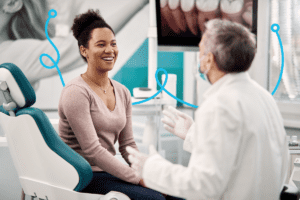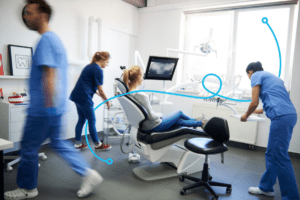Prioritizing the Patient Experience
If we want you to take anything away from this blog post, it’s that you can’t scrimp on providing a good patient experience to your patients.
Needless to say, having the technical skills to provide great oral healthcare is a must. It is easy to assume that the patient experience, outside of providing a good healthcare outcome, is a nice extra bonus that does not need to be prioritized.
But, what we are finding is that this is just not true. Many dentists report on the benefits of prioritizing the patient experience.
Let’s talk about what that means.
Where the Patient Experience Begins

To understand how the patient experience unfolds, we have to think about where it starts. Your patients come from somewhere, of course!
Patients come to your practice via two main routes: either via their own research or via referral.
To select a dentistry practice, many patients do their research themselves. In fact, many patients will come to your practice because they Googled “dentist [their location]”. They will end up choosing your practice at least in part because of patient reviews. In fact, what we know is that consumers will generally utilize social reviews to select a business or a product. Patients are no different when selecting a dental practice.
They want to know how other patients felt when they went to your practice. It’s as simple as that.
Patient reviews are valuable not only because they inform prospective patients about how your current patients feel, but they also improve your visibility in the Google algorithm, making it easier for potential patients to find you.
Or, especially if you are a specialty practice, your patients might get referred by their general practitioner. Just because your patients are not coming to you based on the recommendations of other patients, that doesn’t mean that the patient experience doesn’t factor in. If they do not have a positive experience, they will report that back to their GP – which may result in fewer referrals.
Whether they come to you by research or referral, once your patients make contact with your practice, we need to understand the next stage of the patient journey: their appointment
Bringing the Patient In
The next stage of the patient experience takes place through direct interactions with your practice. The patient has made contact and it’s time for them to come in for their appointment.
Everyone in the modern age is busy. We live in an age of instant connection, notifications, and reminders. When your patients interact with any other service, there is likely some sort of text reminder involved. Think, for example, of the reminders you receive when you take your pet to the veterinarian or have your hair cut.
To a certain extent, healthcare services are obliged to keep up with this trend of convenience. Understanding this stage of the patient experience includes understanding how patients communicate.
Let’s say, for example, that yours is an OMS practice. Your patient has to come in for an extraction. Consider the following for their initial consultation:
- The patient needs to fill out intake and medical history forms.
- They have never been to your practice before, so they need to know the location and parking or transit information.
- Either now or before their procedure, they will need to fill out forms consenting to it.
Consider how the patient can be supported. Reminders about the forms, as well as an appointment reminder, increase the likelihood that the patient will be prepared for their appointment. The reminders for their appointment might include:
- Pre-medications
- Fasting
- A designated pick up person
- And more
Again, the key to this stage of the patient journey is understanding how the patient communicates. Do they prefer to be communicated with by text? By phone? Allowing patients to fill out digital versions of the forms can increase accessibility. They are less likely to lose a digital form than a hard-copy, paper one, after all! Offering this accessibility will support a successful healthcare outcome.
Face-to-Face with the Patient

We have come to a very important moment in the patient experience: what happens to the patient at your practice?
In a blog earlier this year, we explored how workplace culture and core values were integral to an orthodontic practice. Of course, these are important not just for an orthodontic practice! They are important for general practices and specialties alike.
Culture and values directly affect how your patient relationships are shaped. In this, we can take our cues from other businesses. In many ways, dental practices function both as healthcare providers as well as businesses. But, because you are working with patients on their health, this becomes that much more important.
Do you know the answers to the following three questions?
- Does your practice have clearly defined expectations for your workplace culture?
- Does your practice have core values that all your staff are aware of?
- And if the answer to these two questions is ‘yes’, what are those expectations and those values?
If the answer to the first two questions is no, however, this will probably show in your interactions with your patients. We will return to culture and values. But, for now, the most important thing to note is that patients will notice when your staff is not on the same page.
Understanding the patient experience at your practice means understanding what patients value.
Most importantly, what we know is that respect and dedication are deeply valued by patients. Keeping respect at the center of all patient interactions is key for every dentistry practice. This can include:
- Listening to patients’ concerns and fears
- Answering questions thoroughly
- Inviting feedback from the patients right in the room
Now that your patient is at your practice, this is your opportunity to show that respect and dedication!
Patient Experience as a Cycle
What is the payoff in understanding how the patient experience unfolds at every stage of the patient’s journey?
We see the payoff in how the cycle continues. Remember, many of your patients started out selecting your practice based on online reviews. After your patient has completed their appointment or any follow-up appointments, you can ask for their feedback. Benefits to this include:
- Finding out how your patients feel about your practice
- Identifying ways you can improve the patient experience
- Asking them for a review on the online platform of your choice
This will enable you to make adjustments to how your practice offers care if needed. And, it will turn your patients into online advocates for your practice. Their positive Google review, for example, boosts you in the algorithm and becomes the review that the next prospective patient reads.
As you can see, the patient experience matters to the sustainability of your practice. Providing a good patient experience helps bring more patients into your practice.
Diving Into Culture & Values

Let’s go back to how culture and values affect the patient experience. It’s important to note that patients are more likely to feel positive about their healthcare outcome if they feel positive about their patient experience. This tends to be true regardless of what their healthcare outcome is.
As we talked about earlier, patients value respect and dedication. Certainly, as a practice, these might be things you value as well!
But finding out what your core values are as a practice takes some reflection. But, identifying and summarizing these core values is valuable – even necessary – for any business. Knowing what yours are will set you apart from other dental practices in your community. And, it will help your staff understand how to deliver that patient experience because they will know what the expectations are.
To start, ask yourself some key questions:
- What do I think are the most important values for this practice?
- What will patients feel are the most important values for my practice?
- What experience do I want my patients to have at my practice?
In answering these questions, you might find that one word that comes up is transparency. Ensure your patient understands what’s going on with their dental health. Ensure they understand the procedure and potential outcomes. If you are transparent about everything from the procedure to the cost, this will instill trust. It also shows that you are holding yourself accountable. Accountability is also incredibly important to patients. Core values are also only as good as your delivery, so consistency is a key value as well.
Once you know what your core values are, you will be able to build your practice and your patient experience around that!
Some Tips to Consider
So how does workplace culture affect the patient experience? A lot of that comes back to your core values. If you want your team to carry out those core values, there are some key ways to create a workplace culture that supports that!
We’ve identified three helpful strategies to create a supportive workplace culture:
- Prioritizing the well-being of the patient. This is important not only for their oral healthcare but also for their mental and emotional health. Treat the patient well from the moment they step through the door of your practice.
- Choosing the members of your team carefully. Your hiring process should be focused on choosing employees who embody your core values. If you set these expectations for how patients need to be treated during the hiring process, your employees are that much more likely to meet them. It will be part of the fabric of your practice.
- Remembering your patients’ names! This may seem simple. But, it goes a long way! Knowing patients by name will help them feel like an integral part of your practice.
How Patient Perception Factors In

You may have noticed as you read this blog that, at the core, we are talking about how patients perceive your practice. Why is this so important?
In one of our other blog posts, we talked about how perception is important at the pediatric practice. Specifically, this is true because you have to consider not just the perceptions of the child/teenage patient. You also have to consider the perceptions of the parent!
But, managing patient perceptions is important in any practice. Think about the tip “remembering patients’ names”. Remember when your own healthcare provider remembered you and called you by name? Think about how that made you feel.
This is a key part of perception: it matters how we are treated. As a dentist once noted on his blog, building relationships is foundational to dentistry. That treatment truly matters.
It is difficult to manage patient perceptions in a vacuum. You need to know what your patients’ perceptions even are! Some ways to be proactive about this as a practice include:
- Sending patient experience surveys. This type of survey allows you to ask how your patients felt about their overall experience at your practice. This survey might answer questions like how they felt about your staff, your facilities, and your space.
- Sending patient satisfaction surveys. There is an important difference with this type of survey. This type of survey asks a bigger question about patient expectations. You will be able to determine if your patients’ expectations were met or exceeded. You will be able to discover if they are satisfied with their oral health outcome.
- Creating a culture of feedback. Inviting feedback during a consultation or an appointment will show that you are approachable. It will show that you care about your patients’ feedback
Learning about your patients’ perceptions will enable you to re-shape those perceptions, if need be!
What to Make of All of This
You might well be asking, what do we do with all this information about the patient experience? What are you supposed to make of it as a practice?
Certainly, it can be a lot to take in! It’s enough to worry about ensuring you have the right technical skills. Let alone delivering a good patient experience!
Something we always come back to on this blog is the fact that patients are busy. Our culture is one of instant connection. Many of us are constantly contactable by work, by our social circle, and more. Your patients are coming to expect that level of instant connection when it comes to their healthcare providers.
What this tells us about the patient experience – their perception, their treatment, their journey – is that it needs to be accessible. Some things to bear in mind to make it accessible include:
- Communicating in the medium of their choice. Find out if your patients prefer a phone reminder of an appointment, for example, or if they prefer a text.
- Efficiency for your staff makes efficiency for your patients. If your staff has the tools to process your patients efficiently, then your patients can only stand to benefit. Are there any inefficiencies that you can identify that free up your staff’s time? Manual filing, for example?
- Only gather the information you need. If your message to a patient includes questions (a survey or an intake form, for example), only request the information you need. Make it easy for the patient to provide you with that information.
Let’s use two examples to see this in action.
The Patient Experience in Action

Let’s use a teeth cleaning appointment with a general practitioner as an example. Let’s say that the patient in this instance wants to be communicated with by text. They receive a reminder that they are due for teeth cleaning. Then, once they’ve been booked in, they are sent a reminder for their appointment.
While they are at the appointment, the dental hygienist walks them through the procedure, which is a familiar one. After their appointment, the receptionist pulls up their file easily from the computer, bills their insurance directly if possible, then automatically sends a survey link via text. The patient easily finds it later, in their text message history. The survey asks them specific questions about their particular procedure, then prompts them for a review if their response was positive.
For another example, let’s consider a pediatric patient who needs braces. The consultation has already occurred. Their parent or guardian receives a booking confirmation for the appointment. Then, 24 hours before the appointment, the parent or guardian will receive a reminder with any pre-appointment instructions.
At the appointment, the dentist will explain the procedure fully. The dentist will also invite any remaining questions. After the braces have been put on, the parent/guardian will be booked into any follow-up appointments at reception or via a link to their email. The receptionist pulls up their file easily from the computer, bills their insurance directly if possible, then automatically sends a survey link via email. The parent/guardian easily finds it later, in their email inbox. The survey asks them questions specific to their appointment, then prompts them for a review if their response was positive.
These are just some examples of what the patient experience can look like. How does it look at your practice?
A Quick Word About Patient Wait Times
One of the biggest frustrations that someone might encounter in their patient experience is a long wait time.
There are a lot of things that can contribute to a long wait time. Sometimes, it is just unavoidable! Certainly, every procedure has to be done carefully and conscientiously. Sometimes, this will mean delaying other procedures so that this one can go smoothly.
However, there are ways to decrease wait times overall at your practice. One of the key ways is to give your staff the right tools. Ask yourself:
- Where are my staff losing time? Is it in filing? Calling people to remind them of appointments?
- What are the tools that my staff need? Training on how to use time efficiently? Or do they need software to help them carry out their duties?
- Do my staff members understand what is under their purview? Could they be sharing tasks more efficiently?
Finding a way to decrease some of those inefficiencies will help reduce those wait times. Which, of course, results in happier patients!
How Patient Communication Software Helps

One of the ways to make a good patient experience deliverable is through software. Patient communication software allows you to make a lot of your communication automatic. This enables your staff to automate surveys and appointment reminders alike. This can save a lot of time on manual tasks. This not only creates a more efficient practice, but truly enables staff to deliver the caliber of patient experience that you want to deliver.
What we see at Intiveo is that when our clients make the switch to patient engagement software, their patients respond positively. Wayside Dental Centre, for example, saw a 500% increase in patient reviews. Their patients want to be advocates for their practice. Centre Dentaire Tracadie-Sheila saw a 70% increase in confirmation rates. This speaks to the responsiveness of their patients.
The takeaway is that it doesn’t have to be hard. Making the switch to automation can be a learning curve – but once on the other side, you can begin to reap the benefits.
Prioritizing Patient Experience: The Key to a Sustainable Dental Practice
By taking into account your patients’ journey, their perceptions, and your practice’s culture and values, you can see the importance of the patient experience. Taking into account your patients’ time and well-being goes a long way to creating a sustainable dental practice. Offer the tools to your staff to facilitate this experience!
Feel free to browse our resources to see how Intiveo can help you on your patient experience journey. Plus, if you’re curious to learn more about Intiveo’s software, book a meeting today!







